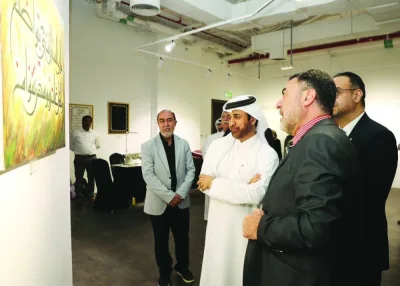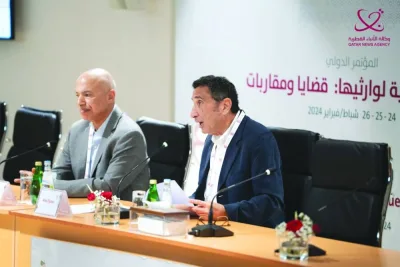The American School of Doha (ASD) recently held its first Arabic Book Fair, co-ordinated by the associated Arab Mother’s Association (AMA).
Three publishers, Dar Asala, Dar Kalimat and Hachette A. Antoine, provided a large selection of Arabic books for various grade levels. Students
from each division were given the opportunity to attend the fair and were included in a raffle awarding two winners with a book.
This book fair was important for the AMA because the group says it “feels strongly about ASD students progressing in their Arabic reading
levels.” They hope to encourage literacy in two or more languages by providing students with the resources necessary for achievement.
Hoda al-Mansoori, President of the AMA, was very proud of the success of the Arabic Book Fair. She said, “One of the main goals of the AMA is
to enrich the school’s libraries with Arabic books and resources to provide the students with a wider variety. Therefore, we have donated
QR10,000 worth of books to the ASD libraries.”
There was a special guest appearance by Qatari author Shaikha al-Zeyara who was on campus signing copies of her children books, The Stranger, I
Want to Be a Mom and Princess Ameena. Shaikha al-Zeyara published her first children’s book in 2009, but began writing long before. She read
her stories to her daughter and was then encouraged to write books. She appreciated the opportunity to visit the Arabic Book Fair. “Although
ASD is an American school, its students are multicultural and many of them speak Arabic. It is important for children to know their mother
language and to be proud of speaking and reading in Arabic.”
ASD Director Dr Deborah Welch was “extremely impressed” with the quantity and quality of the books offered at the fair and stated. “The Arab
Mothers Association has brought Arabic children’s books to ASD to promote the enjoyment of reading and the development of literacy. This is the
first year of this endeavour and it has been so successful that we hope it continues annually.”
“This kind of stuff needs an artistic mind. These kinds of photos are challenging as an artist. How to come up with ideas that have never been
attempted before and then to execute them for people to see is a challenge in itself and here I am. I like challenging myself,” says al-Mannai.
Each and every picture is produced in an intricate manner, giving attention to every detail, including lighting, effects, positioning of
subjects and objects, depth and detail of colours and the overall look.
How did they go about the production of photographs?
“Indeed, this exhibition is like production for us. We had deadlines for different segments of our work. First, we did interviews for our
models, to pick the models that we needed. For example, we needed an old man, an old woman, children, a bride and a groom,” says al-Mannai,
counting the models featured in the photographs.
They had already decided what they are looking for in each person. In an elderly man, for instance, they wanted him to have an old-fashioned
beard and ageing skin for the photograph. This was to create a picture that the viewer can instantly connect with.
Models selected, they went to take photographs. There are some photos that are connected to each other, for instance, the ones showing mothers
with the children. So they had to shoot these pictures the same day. The shoots were timed accordingly.
However, the shooting was not done in a single go. Al-Mannai says this project took more than a year, almost 18 months. Right from selecting
the models to planning the shoots and then the post-production work of editing and printing them for the exhibition took this much time.
“And we are not going to stop here. We will go bigger and bigger. For now, we have to tell people that here we are. We are six people talking
about our community, about our history; the things that people do not know,” says al-Mannai.
“Let me tell you something interesting. It is something that people told us after coming here and seeing this. And it was new for us because as
Qataris we did not look at it this way perhaps,” he goes on to add.
“There were some people from America or Europe who told us that it (Zabra exhibition) was something really meaningful for them. Every time they
would go to Souq Waqif and they would see these things there, they did not understand their purpose and value because they did not know the
story behind it.
“Now, after coming to this exhibition, they know the story and now if they go to Souq Waqif, they know this is something big because there is a
very romantic and touching story behind it. So they thanked us,” says the artist.
Al-Mannai says it was heartening to hear this and it made them realise that they have done something for the people.
“We do not want only Qataris to see this. With this, we want our younger generations to learn about our traditions and we want foreigners to
see this and understand our culture,” says the artist about the exhibition.
Why is the theme of the photographs black-and-white?
“This is very important point. We have chosen a black-and-white combination because the photographs are talking of an old era and the people
from that era are no more. That is why it is black because they do not exist anymore,” explains al-Mannai.
“But the parts of the picture that have colour mean that these things still exist in our culture. These things are still alive. The gold, the
‘Zabra’ itself exists in our culture even if those people are gone. For instance, this ‘Dardala’, the traditional coffee pot, still exists with
us and that is why it is coloured in the photograph,” he adds.
The exhibition is underway till January 29 at Building 19, Gallery II at Katara Cultural Complex.

TOGETHER: Shaikha al-Zeyara with ASD students during the fair.


